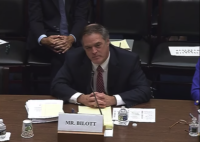A defense bill released by a congressional conference committee Dec. 9 dropped provisions that would have restricted discharges of per- and polyfluoroalkyl substances—a class of chemical compounds known as PFAS—from manufacturers into water supplies and designated PFAS as “hazardous substances” under the federal Superfund law.
The provisions, sought by environmental advocates and others, would have also required utilities to reduce the amount of PFAS in tap water under the Safe Drinking Water Act. Many environmental advocates viewed the $738-billion act as their best opportunity for addressing PFAS during this session of Congress.
“It’s not our only chance, but it was our best chance,” says Scott Faber, the Environmental Working Group’s senior vice president for government affairs. He adds the U.S. Environmental Protection Agency has been moving at a snail’s pace to do anything to protect communities struggling with PFAS-contaminated water and has not committed to do anything specific yet.
On Dec. 4, EPA sent a “proposed regulatory determination” to the Office of Management and Budget for interagency review. The determination would call for further evaluation of two specific compounds—perfluorooctanesulfonic acid (PFOS) and perfluorooctanoic acid (PFOA)—in drinking water for potential regulation under the Safe Drinking Water Act. Although the nature of the determination has not yet been made public because it has not been finalized, a positive determination would set the stage for the development of a regulation under the Safe Drinking Water Act.
Sen. Tom Carper (Del.), the top Democrat on the Environment and Public Works Committee, slammed lawmakers from both parties for jettisoning “a principled compromise measure to begin cleanup at military sites and in communities throughout the country for just two of the most harmful legacy PFAS chemicals.” Fifty-three senators supported the measure, he said in a statement.
The final report for the National Defense Authorization Act of 2020 is the culmination of months of negotiations by a conference committee and will next go to both chambers for final approval before it can be signed into law
PFAS contamination is a pervasive problem. As of March, at least 610 locations in 43 states were known to be contaminated with PFAS chemicals, including drinking water systems serving about 19 million people, according to the Social Science Environmental Health Institute in Boston. The number of known contaminated sites was 172 in July 2018. Exposure to high PFAS levels has been linked to thyroid and other types of cancer.
While environmental groups are frustrated at EPA’s pace, water utility advocates note the agency is following its action plan to address PFAS contamination. EPA has been “moving along with what it has committed to doing,” says Steve Via, director of federal regulations at the American Water Works Association.
EPA also is moving forward with its evaluation process to determine which PFAS chemicals are a threat to human health and the environment. “PFAS is a very large group—potentially thousands of chemicals,” Via says. Water utilities need to know which specific chemicals within the entire class are harmful to the environment and human health, as well as at what thresholds, before regulation makes sense, he adds.
But Faber says, “The science is clear. PFAS causes cancer,” and attempts to say otherwise are “shameful.”




Post a comment to this article
Report Abusive Comment